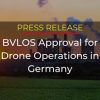Earlier month, I had the honor of delivering a keynote at this year’s Calcalist Industrial Conference in Tel Aviv. In a session in the “Implementing New Technology in Legacy Industries” track, I explained how autonomous drone technology is dramatically impacting industrial profitability by lowering downtime and slashing overhead for large-scale industrial sites in Israel and abroad.
It turns out that globally, heavy industrial sites lose hundreds of billions of dollars a year from downtime. Some of this, of course, results from planned maintenance and other necessary initiatives. But much industrial site downtime is unexpected, and large industrial players are losing 5-10% of their production capacity because of it. When you’re talking about multi-billion dollar industrial giants like our client Israel Chemical Industries (ICL), unplanned downtime can result in serious losses.
Existing Monitoring Solutions Fall Short
What are companies doing to mitigate these losses? Until now, they’ve relied largely on sensor-based monitoring and manual inspection.
Sensor-based monitoring tracks data gathered from sensors on key machinery or site locations, watching for readings that indicate an existing problem or may predict a future problem. Yet in a massive industrial site like ICL’s Dead Sea Works (and others), integrating sensors into every single piece of equipment isn’t logistically, technically or financially feasible. This means that only certain elements of sites are monitored – leaving other potential points of failure exposed and unmonitored.
Manual inspection, on the other hand, involves sending teams into the field (and often into dangerous situations) to check equipment piece by piece. For a large site, these manual inspections can take months or longer, resulting in very high overhead. Moreover, in some cases, these inspections require shutting down the equipment inspected, which in itself degrades productivity.
Clearly, neither of these methodologies are sufficient by themselves to truly mitigate the losses from unplanned downtime.
The Alternative
The alternative is persistent and consistent visual asset monitoring. According to one study, such data-driven maintenance can result in a 35-45% reduction in downtime, a 20-60% increase in output or production, and a 40-50% increase in labor productivity. The key to achieving these results? Autonomous drones.
Flying without costly human pilots on pre-scheduled and pre-programmed routes, autonomous drones provide a massive boost to existing efforts to improve preventative maintenance and reduce unexpected downtime. Autonomous drones both supplement existing monitoring efforts and provide perspectives other solutions simply can’t offer.
For example, in ICL’s Dead Sea Works, an on a Percepto autonomous drone, running our computer vision algorithm, regularly monitors the wholly-owned power grid that serves the facility. On one such flight, the algorithm picked up a temperature differential on an unmonitored element of the grid. Such overheating, which would not have been detected in a standard annual inspection, is indicative of imminent failure. As a result, the part was immediately replaced – and unnecessary and potentially expensive downtime was averted.
Dead Sea Works also uses the same multi-mission drones for an unrelated, yet similarly business-critical mission: pile inspection, to help determine production rates. By leveraging Percepto’s inherent flexibility, ICL enjoys even faster overall system ROI.
The Bottom Line
In a time of increasing global competition, industrial downtime can mean the difference between profit and loss. By adopting autonomous drone solutions to fill in the gap between manual and fix sensor-based monitoring, industrial players like ICL can dramatically lower unplanned downtime and raise output.





